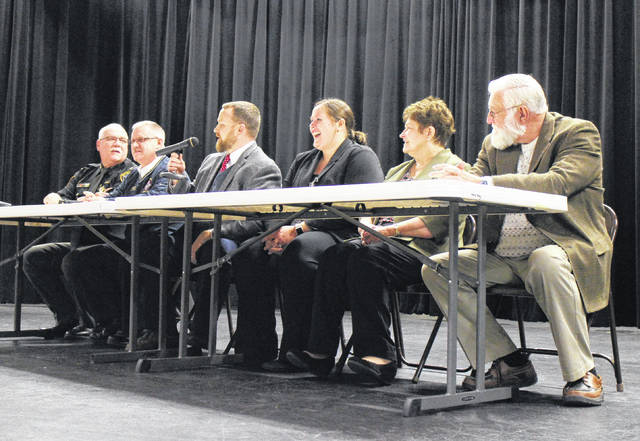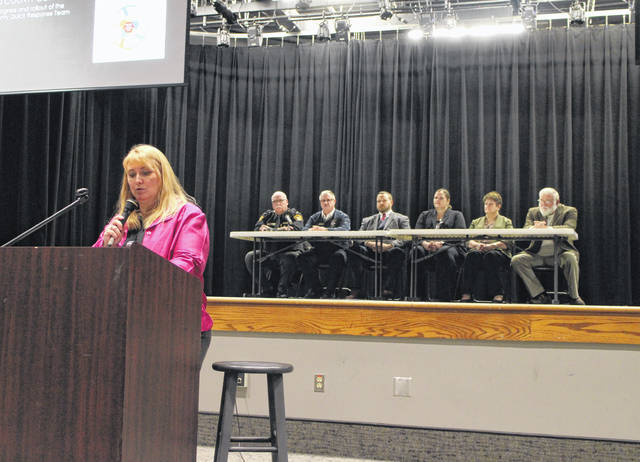

A sheriff, a preacher, a fire chief, two mental health experts and a health commissioner gathered on Tuesday at Southern State Community College with a common set of goals — to save as many lives as possible from drug addiction, and put an end to the opiate crisis here for good.
The specialized group, known as the Quick Response Team, will in coming months visit people who have overdosed on drugs, encourage them to seek recovery, and provide them with the resources they need to get treated for addiction.
As previously reported, the team is funded by grants from the Ohio Attorney General’s Office and Cincinnati nonprofit Interact For Health, and includes officials and professionals from an array of local entities.
The six members present on Tuesday were Highland County Sheriff Donnie Barrera, Paint Creek Joint EMS/Fire District Chief Dave Manning, Highland County Health Commissioner Jared Warner, Gena Bates of the Scioto Paint Valley Mental Health Center, Pat Friel of Friel and Associates, and local pastor Larry Maynard of Lakeside Ministries.
Not present on Tuesday was Creed Culbreath, an investigator for the Highland County Coroner who will serve as a hospital liaison for the group. Culbreath has already paid visits to a number of overdose survivors and offered them treatment resources.
More entities and individuals are expected to join the QRT in coming months, organizers have said.
Heather Gibson, president of the Highland County Drug Abuse Prevention Coalition and CEO of REACH for Tomorrow, a local nonprofit, introduced the group at the event Tuesday evening, which drew about 40 people.
Many of those in attendance frequently attend monthly coalition meetings or are in some way involved in local drug abuse prevention activities.
Also on hand at the event were Dr. Kelly Firesheets of Interact For Health and Carol Baden, an outreach specialist for the Ohio Attorney General’s Heroin Unit.
Firesheets and Baden lauded the group for their commitment to fighting the opiate epidemic, and Firesheets said she has been impressed with Highland County’s efforts in the crisis.
“Look at this group of people,” she said. “I don’t see this everywhere… I know for you guys, it’s been a really long slog, but you’re making a difference and doing really good work.”
Baden agreed.
“Highland County is crushing it,” she said.
Barrera said he has seen a “steady increase” in community involvement in the drug epidemic, especially with the Highland County Drug Abuse Prevention Coalition.
The coalition, which was instrumental in the formation of the QRT, is a group of concerned citizens and officials who meet monthly to exchange ideas and resources for preventing local drug abuse.
Manning said QRT members have their work cut out for them, since the Paint Creek district alone responded to more than 250 drug overdose calls in 2017.
But, he said, “I’m excited to get started… We look forward to being part of the team.”
According to Warner, the QRT will use an advanced data tracking system to determine the success of people with whom the QRT makes contact in hopes of illustrating the group’s long-term effectiveness.
Once contact is made with an individual, Gibson said, they will be given a packet of treatment resources and possibly be assessed for treatment on the spot. If they wish to seek immediate help, QRT members will identify a place for them to stay short-term.
Maynard, who runs a women’s recovery housing space in the Rocky Fork area, said his ministry will offer short-term housing for women while they detox and wait for long-term treatment.
Maynard said he believes the opiate epidemic is a spiritual issue, and not enough churches are involved in the efforts to curb it.
Friel, who is part of a group in Ross County similar to the QRT, said groups like the QRT have seen a high rate of success.
“I’m looking forward to serving in the Greenfield area because I know it works,” she said.
Bates said she believes one of the most important aspects of the QRT is that its members, including law enforcement, will be “friendly faces” to addicts, rather than an intimidating force.
Gibson gave a brief outline of the drug abuse coalition’s Community Plan, which highlights five specific areas on which local resources should be focused, including harm reduction, supply reduction, drug abuse prevention, treatment and advocacy.
Gibson also fielded questions from the people in attendance, and discussion ranged from local treatment options to some of the more unpopular methods of fighting drug abuse.
One such method, according to Warner, is a needle exchange program, which he described as the “biggest political nightmare at the health department in Highland County.”
Warner and Firesheets said while they believe needle exchange programs are vital to staving off outbreaks of communicable disease, the idea has not been well-received here.
As previously reported, Firesheets recently said the assembly of the QRT is somewhat of a second phase to naloxone distribution programs Interact for Health has sponsored — another harm reduction method that has proved somewhat controversial.
Naloxone, sold under the brand name Narcan, is a drug that reverses the effects of opiate overdose, and its free distribution to the public by the Highland County Health Department received mixed reviews.
Some officials and community members have said giving naloxone away for free encourages drug abuse since it lessens the risk of dying from an overdose.
Others, like Warner, have said any measure to prevent fatalities is worth the cost.
Firesheets recently told The Times-Gazette that Narcan distribution itself actually does little to solve the overall drug problem, since many who overdose and are treated with Narcan tend to go right back to using opiates because of their addiction.
Firesheets said the goal of the QRT is to follow up with those who have survived overdoses and convince them to seek treatment options, adding that it’s “fair to say we haven’t been doing a good job of that.”
Near the end of the event, a woman who said she had formerly been addicted to drugs, said she was “amazed” and “encouraged” to see the QRT assembled.
Reach David Wright at 937-402-2570, or on Twitter @DavidWrighter.



